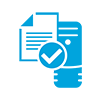System Requirements and Installation Prerequisites

Complete each prerequisite before proceeding to step 2.
- Have the License Key included in the new purchase email you received from ESET ready. I lost my License Key.
- Verify your server and workstation operating systems are ESET compatible.
- Uninstall any previously installed antivirus software.
- Identify your system architecture type. The 32-bit architecture is not supported for ESEST PROTECT 8.0 Server component.
On your intended ESET PROTECT Server machine:
- Verify that all required ports are open and available.
- Install Java Runtime Environment with the same bitness as your Tomcat installation (64-bit)

- Install the .NET 4 if you are going to install the MS SQL Express using the ESET PROTECT 8.0 All-in-one installer.
- Determine if you have a database configured for use with ESET PROTECT Server. Note that Maria DB is not supported by ESET PROTECT. Microsoft SQL Server Express is included with the installer. We also recommend Microsoft SQL Server or MySQL (versions 5.6, 5.7, 8.0).
 Install ESET PROTECT Server
Install ESET PROTECT Server

Install ESET PROTECT Server. When ESET PROTECT Server is installed, continue to Step 3 below.
 Add Client Computers
Add Client Computers

Add client computers to the ESET PROTECT. Once you have successfully added all client computers, continue to Step 4 below.
 Deploy the ESET Management Agent
Deploy the ESET Management Agent

Small-to-medium businesses: Follow our deployment instructions for client operating system(s) in your network:
Enterprise Deployment: Many large networks use GPO or SCCM, see our instructions to deploy ESET Management Agent to your network using one of these methods.
Once you have successfully deployed the ESET Management Agent to all endpoints, continue to Step 5 below.
 Install ESET Solutions on Client Computers
Install ESET Solutions on Client Computers

Deploy ESET endpoint products to your client computers. Once you have successfully installed ESET solutions on all client computers, continue to Step 6 below.
 Post Installation Tasks
Post Installation Tasks

Congratulations! You are now ready to manage your network using ESET PROTECT. The following articles will assist you in the completion of post-installation tasks:
- After installing ESET solutions on clients, you can create static or dynamic groups to organize your endpoints and begin enforcing policies.
- Create, assign or schedule a new server task. For example, refer to the following Knowledgebase article: Generate a report in ESET PROTECT (8.0).
- Create or manage your notifications.
- Organize your licenses.
- Manage client computers using tasks. For example, refer to the following Knowledgebase article: Send a Modules update task to clients using ESET PROTECT 8.0.
Reactie toevoegen
Log in of registreer om een reactie te plaatsen.